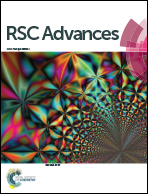Engineering microtubular SnO2 architecture assembled by interconnected nanosheets for high lithium storage capacity†
Abstract
Recent attention has been focused on the synthesis and application of hollow and porous structured micro-/nano-materials since this kind of structure exhibits unique advantages for electrode materials. Herein, we report an interesting approach for efficient synthesis of hollow SnO2 microtubes assembled by interconnected nanosheets. On the basis of self-sacrificing template technology, hollow SnO2 microtubes were successfully synthesized via a one step facile hydrothermal route using a natural biological substance (here, it is cotton) as template without further post treatment (high temperature or strong acid or base). The as-synthesized hollow SnO2 microtubes integrate two beneficial features: hollow cavity and porous shell, which are beneficial for accommodating large volume variation and facilitating fast and full electrolyte access to SnO2 nanosheets. When evaluated as an anode for lithium ion batteries, they exhibit high reversible capacity and good cycle performance. Our findings provide an effective solution for the synthesis of hollow and porous micro-/nano-architectures, which can pave the way to improve the electrochemical performance of electrode materials.


 Please wait while we load your content...
Please wait while we load your content...